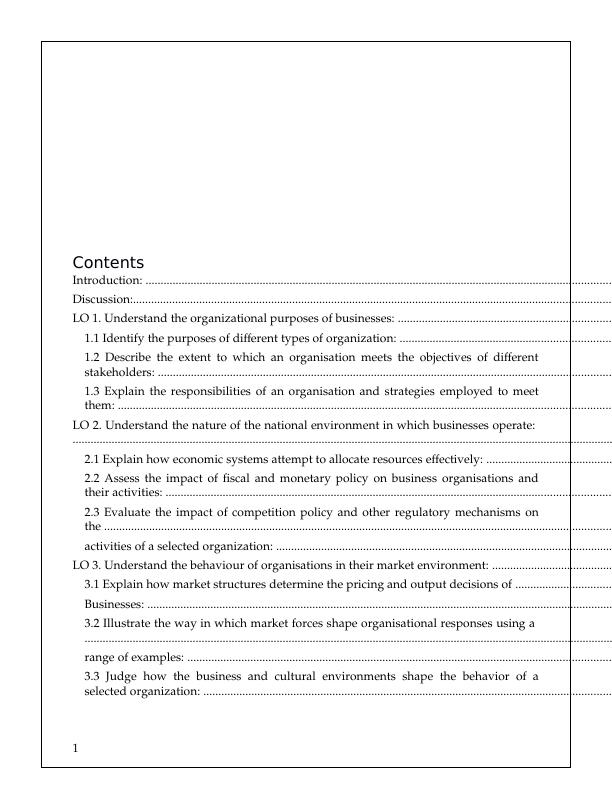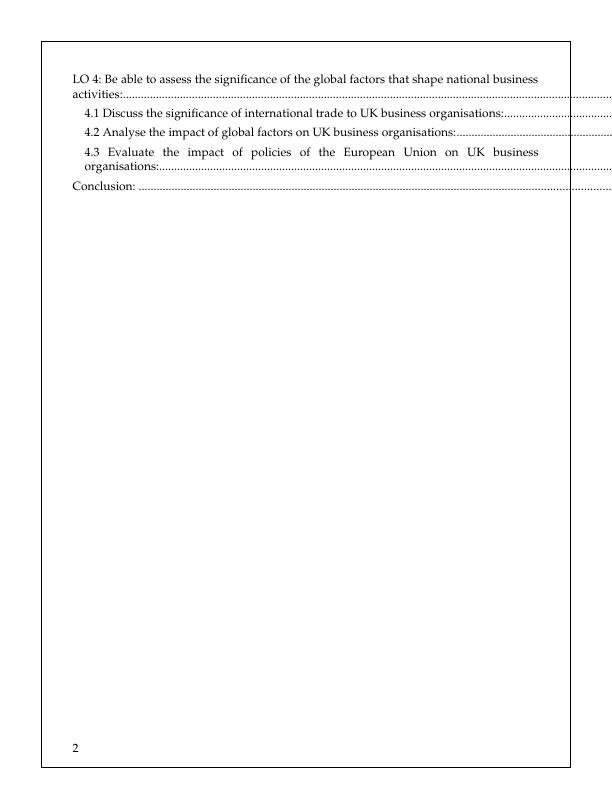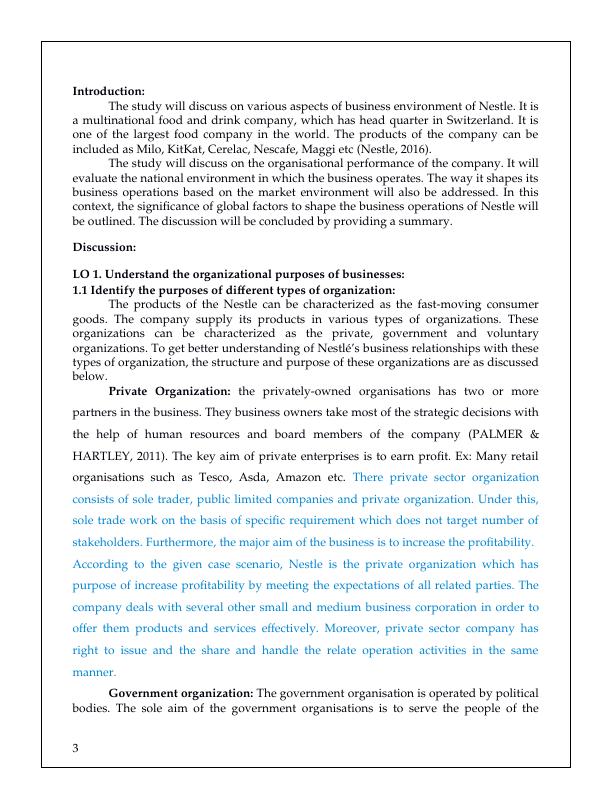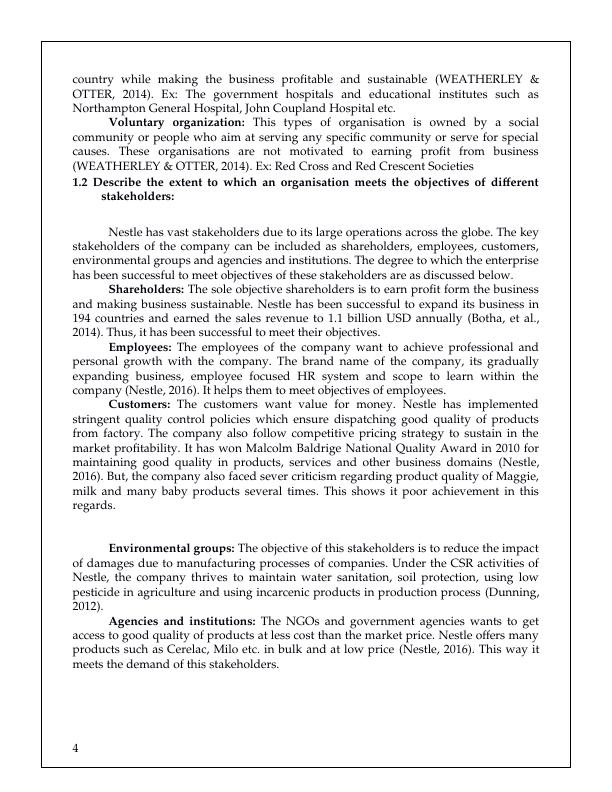Understanding the nature of business: 3 Discussion
16 Pages4838 Words68 Views
Added on 2020-01-07
About This Document
Understand the organizational purposes of businesses:3 1.1 Identify the purposes of different types of organization: 3 1.2 Describe the extent to which an organisation meets the objectives of different stakeholders:3 1.3 Explain the responsibilities of an organisation and strategies employed to meet them: 4 LO 2. Understand the nature of the national environment in which businesses operate: 5 2.1 Explain how economic systems attempt to allocate resources effectively: 5 2.2 Assess the impact of fiscal and monetarypolicyonbusiness organisations and their activities: 7 2.3
Understanding the nature of business: 3 Discussion
Added on 2020-01-07
ShareRelated Documents
Contents
Introduction: .................................................................................................................................................................
Discussion:.....................................................................................................................................................................
LO 1. Understand the organizational purposes of businesses: .............................................................................
1.1 Identify the purposes of different types of organization: ............................................................................
1.2 Describe the extent to which an organisation meets the objectives of different
stakeholders: .............................................................................................................................................................
1.3 Explain the responsibilities of an organisation and strategies employed to meet
them: ..........................................................................................................................................................................
LO 2. Understand the nature of the national environment in which businesses operate:
..........................................................................................................................................................................................
2.1 Explain how economic systems attempt to allocate resources effectively: ................................................
2.2 Assess the impact of fiscal and monetary policy on business organisations and
their activities: ..........................................................................................................................................................
2.3 Evaluate the impact of competition policy and other regulatory mechanisms on
the ...............................................................................................................................................................................
activities of a selected organization: ......................................................................................................................
LO 3. Understand the behaviour of organisations in their market environment: ..............................................
3.1 Explain how market structures determine the pricing and output decisions of ......................................
Businesses: .................................................................................................................................................................
3.2 Illustrate the way in which market forces shape organisational responses using a
....................................................................................................................................................................................
range of examples: .................................................................................................................................................
3.3 Judge how the business and cultural environments shape the behavior of a
selected organization: ............................................................................................................................................
1
Introduction: .................................................................................................................................................................
Discussion:.....................................................................................................................................................................
LO 1. Understand the organizational purposes of businesses: .............................................................................
1.1 Identify the purposes of different types of organization: ............................................................................
1.2 Describe the extent to which an organisation meets the objectives of different
stakeholders: .............................................................................................................................................................
1.3 Explain the responsibilities of an organisation and strategies employed to meet
them: ..........................................................................................................................................................................
LO 2. Understand the nature of the national environment in which businesses operate:
..........................................................................................................................................................................................
2.1 Explain how economic systems attempt to allocate resources effectively: ................................................
2.2 Assess the impact of fiscal and monetary policy on business organisations and
their activities: ..........................................................................................................................................................
2.3 Evaluate the impact of competition policy and other regulatory mechanisms on
the ...............................................................................................................................................................................
activities of a selected organization: ......................................................................................................................
LO 3. Understand the behaviour of organisations in their market environment: ..............................................
3.1 Explain how market structures determine the pricing and output decisions of ......................................
Businesses: .................................................................................................................................................................
3.2 Illustrate the way in which market forces shape organisational responses using a
....................................................................................................................................................................................
range of examples: .................................................................................................................................................
3.3 Judge how the business and cultural environments shape the behavior of a
selected organization: ............................................................................................................................................
1

LO 4: Be able to assess the significance of the global factors that shape national business
activities:.......................................................................................................................................................................
4.1 Discuss the significance of international trade to UK business organisations:........................................
4.2 Analyse the impact of global factors on UK business organisations:........................................................
4.3 Evaluate the impact of policies of the European Union on UK business
organisations:...........................................................................................................................................................
Conclusion: .................................................................................................................................................................
2
activities:.......................................................................................................................................................................
4.1 Discuss the significance of international trade to UK business organisations:........................................
4.2 Analyse the impact of global factors on UK business organisations:........................................................
4.3 Evaluate the impact of policies of the European Union on UK business
organisations:...........................................................................................................................................................
Conclusion: .................................................................................................................................................................
2

Introduction:
The study will discuss on various aspects of business environment of Nestle. It is
a multinational food and drink company, which has head quarter in Switzerland. It is
one of the largest food company in the world. The products of the company can be
included as Milo, KitKat, Cerelac, Nescafe, Maggi etc (Nestle, 2016).
The study will discuss on the organisational performance of the company. It will
evaluate the national environment in which the business operates. The way it shapes its
business operations based on the market environment will also be addressed. In this
context, the significance of global factors to shape the business operations of Nestle will
be outlined. The discussion will be concluded by providing a summary.
Discussion:
LO 1. Understand the organizational purposes of businesses:
1.1 Identify the purposes of different types of organization:
The products of the Nestle can be characterized as the fast-moving consumer
goods. The company supply its products in various types of organizations. These
organizations can be characterized as the private, government and voluntary
organizations. To get better understanding of Nestlé’s business relationships with these
types of organization, the structure and purpose of these organizations are as discussed
below.
Private Organization: the privately-owned organisations has two or more
partners in the business. They business owners take most of the strategic decisions with
the help of human resources and board members of the company (PALMER &
HARTLEY, 2011). The key aim of private enterprises is to earn profit. Ex: Many retail
organisations such as Tesco, Asda, Amazon etc. There private sector organization
consists of sole trader, public limited companies and private organization. Under this,
sole trade work on the basis of specific requirement which does not target number of
stakeholders. Furthermore, the major aim of the business is to increase the profitability.
According to the given case scenario, Nestle is the private organization which has
purpose of increase profitability by meeting the expectations of all related parties. The
company deals with several other small and medium business corporation in order to
offer them products and services effectively. Moreover, private sector company has
right to issue and the share and handle the relate operation activities in the same
manner.
Government organization: The government organisation is operated by political
bodies. The sole aim of the government organisations is to serve the people of the
3
The study will discuss on various aspects of business environment of Nestle. It is
a multinational food and drink company, which has head quarter in Switzerland. It is
one of the largest food company in the world. The products of the company can be
included as Milo, KitKat, Cerelac, Nescafe, Maggi etc (Nestle, 2016).
The study will discuss on the organisational performance of the company. It will
evaluate the national environment in which the business operates. The way it shapes its
business operations based on the market environment will also be addressed. In this
context, the significance of global factors to shape the business operations of Nestle will
be outlined. The discussion will be concluded by providing a summary.
Discussion:
LO 1. Understand the organizational purposes of businesses:
1.1 Identify the purposes of different types of organization:
The products of the Nestle can be characterized as the fast-moving consumer
goods. The company supply its products in various types of organizations. These
organizations can be characterized as the private, government and voluntary
organizations. To get better understanding of Nestlé’s business relationships with these
types of organization, the structure and purpose of these organizations are as discussed
below.
Private Organization: the privately-owned organisations has two or more
partners in the business. They business owners take most of the strategic decisions with
the help of human resources and board members of the company (PALMER &
HARTLEY, 2011). The key aim of private enterprises is to earn profit. Ex: Many retail
organisations such as Tesco, Asda, Amazon etc. There private sector organization
consists of sole trader, public limited companies and private organization. Under this,
sole trade work on the basis of specific requirement which does not target number of
stakeholders. Furthermore, the major aim of the business is to increase the profitability.
According to the given case scenario, Nestle is the private organization which has
purpose of increase profitability by meeting the expectations of all related parties. The
company deals with several other small and medium business corporation in order to
offer them products and services effectively. Moreover, private sector company has
right to issue and the share and handle the relate operation activities in the same
manner.
Government organization: The government organisation is operated by political
bodies. The sole aim of the government organisations is to serve the people of the
3

country while making the business profitable and sustainable (WEATHERLEY &
OTTER, 2014). Ex: The government hospitals and educational institutes such as
Northampton General Hospital, John Coupland Hospital etc.
Voluntary organization: This types of organisation is owned by a social
community or people who aim at serving any specific community or serve for special
causes. These organisations are not motivated to earning profit from business
(WEATHERLEY & OTTER, 2014). Ex: Red Cross and Red Crescent Societies
1.2 Describe the extent to which an organisation meets the objectives of different
stakeholders:
Nestle has vast stakeholders due to its large operations across the globe. The key
stakeholders of the company can be included as shareholders, employees, customers,
environmental groups and agencies and institutions. The degree to which the enterprise
has been successful to meet objectives of these stakeholders are as discussed below.
Shareholders: The sole objective shareholders is to earn profit form the business
and making business sustainable. Nestle has been successful to expand its business in
194 countries and earned the sales revenue to 1.1 billion USD annually (Botha, et al.,
2014). Thus, it has been successful to meet their objectives.
Employees: The employees of the company want to achieve professional and
personal growth with the company. The brand name of the company, its gradually
expanding business, employee focused HR system and scope to learn within the
company (Nestle, 2016). It helps them to meet objectives of employees.
Customers: The customers want value for money. Nestle has implemented
stringent quality control policies which ensure dispatching good quality of products
from factory. The company also follow competitive pricing strategy to sustain in the
market profitability. It has won Malcolm Baldrige National Quality Award in 2010 for
maintaining good quality in products, services and other business domains (Nestle,
2016). But, the company also faced sever criticism regarding product quality of Maggie,
milk and many baby products several times. This shows it poor achievement in this
regards.
Environmental groups: The objective of this stakeholders is to reduce the impact
of damages due to manufacturing processes of companies. Under the CSR activities of
Nestle, the company thrives to maintain water sanitation, soil protection, using low
pesticide in agriculture and using incarcenic products in production process (Dunning,
2012).
Agencies and institutions: The NGOs and government agencies wants to get
access to good quality of products at less cost than the market price. Nestle offers many
products such as Cerelac, Milo etc. in bulk and at low price (Nestle, 2016). This way it
meets the demand of this stakeholders.
4
OTTER, 2014). Ex: The government hospitals and educational institutes such as
Northampton General Hospital, John Coupland Hospital etc.
Voluntary organization: This types of organisation is owned by a social
community or people who aim at serving any specific community or serve for special
causes. These organisations are not motivated to earning profit from business
(WEATHERLEY & OTTER, 2014). Ex: Red Cross and Red Crescent Societies
1.2 Describe the extent to which an organisation meets the objectives of different
stakeholders:
Nestle has vast stakeholders due to its large operations across the globe. The key
stakeholders of the company can be included as shareholders, employees, customers,
environmental groups and agencies and institutions. The degree to which the enterprise
has been successful to meet objectives of these stakeholders are as discussed below.
Shareholders: The sole objective shareholders is to earn profit form the business
and making business sustainable. Nestle has been successful to expand its business in
194 countries and earned the sales revenue to 1.1 billion USD annually (Botha, et al.,
2014). Thus, it has been successful to meet their objectives.
Employees: The employees of the company want to achieve professional and
personal growth with the company. The brand name of the company, its gradually
expanding business, employee focused HR system and scope to learn within the
company (Nestle, 2016). It helps them to meet objectives of employees.
Customers: The customers want value for money. Nestle has implemented
stringent quality control policies which ensure dispatching good quality of products
from factory. The company also follow competitive pricing strategy to sustain in the
market profitability. It has won Malcolm Baldrige National Quality Award in 2010 for
maintaining good quality in products, services and other business domains (Nestle,
2016). But, the company also faced sever criticism regarding product quality of Maggie,
milk and many baby products several times. This shows it poor achievement in this
regards.
Environmental groups: The objective of this stakeholders is to reduce the impact
of damages due to manufacturing processes of companies. Under the CSR activities of
Nestle, the company thrives to maintain water sanitation, soil protection, using low
pesticide in agriculture and using incarcenic products in production process (Dunning,
2012).
Agencies and institutions: The NGOs and government agencies wants to get
access to good quality of products at less cost than the market price. Nestle offers many
products such as Cerelac, Milo etc. in bulk and at low price (Nestle, 2016). This way it
meets the demand of this stakeholders.
4

End of preview
Want to access all the pages? Upload your documents or become a member.
Related Documents
Significance of Global Factors in Business- Nestlelg...
|14
|5007
|262
Report On NESTLE | Different Nature Of Businesslg...
|16
|5193
|199
Business Environment Assignment | NESTLE Reportlg...
|13
|5395
|180
UNIT1 Business Environment : Assignmentlg...
|25
|5663
|305
Business Environment of Nestle- Doclg...
|15
|4746
|76
Analyzing Business Environment of NESTLE : Assignmentlg...
|18
|5453
|49
